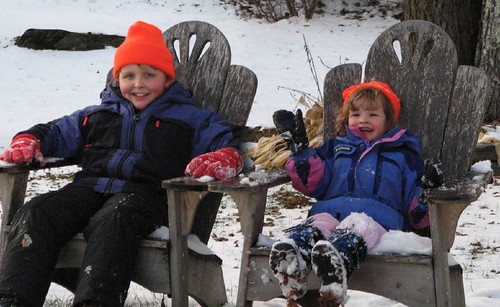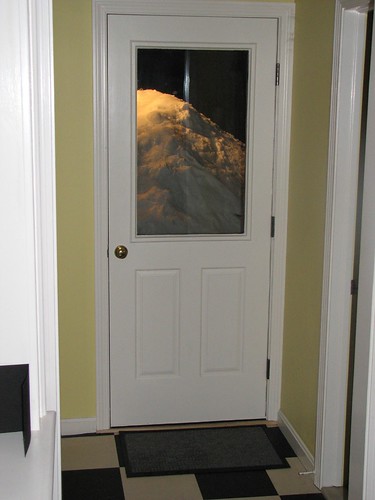
The story of Fergus' diagnosis, treatment, and its reverberations through our life can be told a hundred different ways. Leukemia is so large, elephantine, that it's impossible to capture the whole thing from one angle. You have to come at it again and again from different angles, so you end up with something less like a narrative and more like a mosaic or pastiche, or like a cubist portrait.
When you put all the pieces together you get something that approaches our story, but still doesn't fully convey its essence. And even though some of our friends and family probably mumble under their breath, "Enough with the leukemia talk already," we're still trying to figure out what hit us on November 29, 2004 (Diagnosis Day), and how it has changed/is changing/will change our lives.
So here's one part of the mosaic, this time not even written by me or Lauren. It's a story published in our local paper last fall, written by one of its editors, Susan Allen (and thanks, Sue, for letting us re-post the text here). I'll try to come at this from different angles in the future, but this is a fine start:
Article published Sep 17, 2007
Leukemia hasn't daunted 7-year-old Fergus Ryan
By Susan Allen, Barre-Montpelier Times Argus editor
EAST MONTPELIER – Seven-year-old Fergus Ryan has pulled off the greatest magic trick of his young life.
After being diagnosed with acute lymphoblastic leukemia in December 2004, and spending more than two years undergoing chemotherapy, endless trips to Fletcher Allen Health Care, 18 spinal taps and 3,656 pills of one kind or another – he smiles, jokes and looks like any boy next door.
It's magical.
"Want to see a magic trick?" he asked last week, racing through the dining room of his family's East Montpelier home, hunting for a white gift wrap bow that's part of his act. The curly bow "magically" turns into a tight tied bow while the viewer's eyes are closed.
"Where'd you learn that trick?" he is asked.
"From Marko," he replies, referring to central Vermont's Marko the Magician who performed at Fergus' party to celebrate his last chemotherapy treatment on June 27, 2007. One of his anesthesiologists was also a magician, his mother Lauren notes.
Lauren Quinn, a veterinarian at Onion River Animal Hospital in Montpelier, recalls the ordeal of discovering that her son was facing a fight for his life.
The first signs appeared in October 2004, while attending a wedding outside Vermont when he experienced a fever and stomach pain. The third day, when the symptoms continued, she and husband Rob took Fergus to a pediatrician, who conducted blood tests and found everything normal except some anemia.
Back home in Vermont, Fergus continued to bounce from healthy and happy to complaining about pain and spiking an occasional fever. One day he began crawling because of pain in one leg; he toured the Montshire Museum that day in a stroller and experienced significant pain on the ride home.
Tests showed his white blood cell count normal, but Fergus' doctor advised Lauren to take the boy to a hematogolist (blood specialist) at Fletcher Allen Health Care about the anemia.
"I had a weird feeling about this," she recalled of that visit on Nov. 29, 2004.
The hematologist ran tests, then left the room to review X-rays and blood slides. He took a long time returning, and Lauren and Rob "assumed he was really busy being with sick kids."
"He came back and we knew right away … he said I really hate to tell you this …" The diagnosis was leukemia, Lauren said. "I remember feeling kind of cold. I just felt icy."
Lauren didn't cry for four days. Instead, she shifted into action, calling a doctor at Dana Farber Cancer Center in Boston to talk about treatment options and going online to research the disease. That night she cuddled Fergus, thinking about how his life would change the following day when he was admitted for chemotherapy and officially became a "sick child."
"I thought, 'He's so healthy and normal. What if I just put him in the car and drive away?'" she recalled.
Fergus was diagnosed on Nov. 29, admitted for his first hospital stay on Nov. 30, and started chemotherapy on Dec. 1. That's been his life off and on until June 27 of this year, when he received his last treatment.
"The first time I cried was four days into it," Lauren said. The boy was anxious about the spinal taps and blood draws; he cried but held still throughout his medical ordeals. At the end of the one session, when he was allowed to choose a "prize" for himself, he instead picked a little pink doll to give to his 18-month-old sister Norah.
Lauren Quinn finally broke down.
The couple spent the next 2-1/2 years alternating work schedules, child care, and trips to the hospital (where they brought a lamp and quilts from his room at home to make him more comfortable during his stays). Friends brought meals to the family three nights a week.
Fergus remained healthy looking, but steroids that were part of the treatment wreaked havoc on his emotions. He'd laugh hysterically, then sob. He had food cravings – many kids in this situation crave salty junk food such as chips, but Fergus craved spaghetti and meatballs. His hair thinned and the curls grew coarser, but he didn't go bald, Lauren said.
The treatments were an ordeal.
"Fergus did get a port placed under his skin for all of his chemo," Lauren explained in an e-mail. "It was a central line down toward his heart. To access it, the skin was numbed and a needle was pushed through the skin into this little rubber diaphragm. Fergus dreaded port accesses for most of treatment, and needed a lot of help holding still. By the end he was a pro, and could sit nervously while the needle went in. He claimed he always felt it."
The couple found the experience "a huge challenge," but learned to communicate better and deal with the stress.
"We had to be more tender because we each grieved differently," Lauren said.
Every Sunday, she said, after Fergus had returned from a hospital stay, they'd put on fun music and the whole family would dance for half an hour just to reconnect and burn off the tension.
The family's health insurance covered most of the expenses, which Lauren said was a relief because many families have to fret about the bills during a child's illness, adding to their burden.
Lauren's brother who lives in Seattle wanted to help in some way, and began running in triathlons to raise money for the fight against childhood cancer. Lauren was inspired and she, too, began training for the 2006 Team in Training triathlon (visit www.teamintraining.org for information) in Memphis – and raised $21,000 toward the effort.
Lauren and Fergus took another important step forward in the fight against childhood cancer by traveling to Washington, D.C., in June to attend a national rally for federal funding for the fight against childhood cancer and passage of the Conquer Childhood Cancer Act. Families came from across the country to tell their personal stories of cancer; they asked to meet with their congressional members of staffers.
Lauren and Fergus were the only two from Vermont – and they met personally with Rep. Peter Welch (whose wife died of cancer) and Sen. Bernie Sanders, who signed onto the cancer bill that very day. They also met with a Leahy staffer. Lauren learned last week that Welch and Leahy, too, signed onto the legislation.
Lauren said that in 1967, only 5 percent of children with leukemia survived; now 85 percent can survive. But that figure has leveled off and families are hoping to move research and survival rates forward.
Today Fergus is in long-term remission and doing well. Lauren and Rob worry about a relapse, and confess to occasionally stressing every time the boy – or even his sister – complains of leg pain.
"Every now and then something will happen and I'll get that feeling of being punched in the stomach," she said.
While the experience has been an ordeal, Lauren said there has been a positive side to Fergus' fight.
"It's enhanced our enjoyment of each other and our appreciation of the small daily pleasures," she said. "We will have these moments, the kids are laughing, and Rob and I find each other looking at each other and thinking, 'This is a great moment.'"
Recently she was sitting in the yard looking at the view and imagined Fergus walking up, home from college or his life away, and having a beer and sharing the view.
"I burst into tears because I so desperately want that to happen," she said. But, she reminded herself, "Nobody has that guarantee." Even for cancer-free families, life is a gamble.
"It's been an incredibly hard two years, but on the other hand it's been a delightfully wonderful life with our children for two-and-a-half years," Lauren said. "We've had a good time and we've really enjoyed each other, and we still do. We're more focused on the present."
Lauren said that recently Fergus was watching a video on cancer and looked away as the announcer talked about those who have died of the disease.
"Will I be a survivor?" he asked his mother.
She replied, "You already are."

















